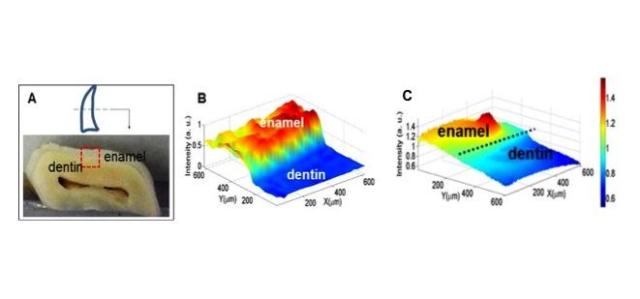Dec 29 2015
Before Case Western Reserve University Professor Ozan Akkus applied for federal funding to build a souped-up version of a chemical analyzer, 11 fellow professors from various disciplines, as well as an art conservation group at the Cleveland Museum of Art, signed on in support, wanting to use the new device.
 A) A tooth specimen was sectioned transversely to expose enamel-dentin junction at which the mineral content increases spontaneously. B) Chemical image of mineral variation at dentin (blue, low mineralization) and enamel (red, high mineralization) junction by classical Raman point mapping that lasted for 2 hours. C) Single FastRAM image of similar region provides the information only in 1 minute. (CREDIT: Ozan Akkus)
A) A tooth specimen was sectioned transversely to expose enamel-dentin junction at which the mineral content increases spontaneously. B) Chemical image of mineral variation at dentin (blue, low mineralization) and enamel (red, high mineralization) junction by classical Raman point mapping that lasted for 2 hours. C) Single FastRAM image of similar region provides the information only in 1 minute. (CREDIT: Ozan Akkus)
Akkus, a professor of mechanical and aerospace engineering, is turning a Raman microscope--one of the workhorses of chemical analysis--into FastRAM, a device that can provide images of materials in seconds to minutes instead of hours to days. The instrument would also allow researchers to analyze dynamic processes such as chemical reactions as they occur, which current technology cannot.
The new technology would reduce the time it takes to make discoveries and the cost of analysis and may provide the first look at a host of dynamic systems, yielding fundamental knowledge of how they operate and insight into how they may be modified to improve output, safety and more.
The National Science Foundation awarded him a $280,000 grant to develop a spectrometer that's faster than current models by a factor of hundred, and in some cases thousand. The grant was supplemented by $60,000 from the Ohio Board of Regents and $60,000 from the Case School of Engineering.
Over the next year-and-a-half, Akkus will work with Case Western Reserve colleagues Andrew Rollins, a biomedical engineering professor who specializes in molecular imaging, Hatsuo Ishida, a macromolecular science and engineering professor who studies molecular spectroscopy of polymers, and Daniel Scherson, a chemistry professor who focuses on Raman and other spectroscopic techniques.
Case Western Reserve faculty members are already planning to use FastRAM to analyze meteors, the chemical reactions inside lithium ion batteries, organic light-emitting diodes, solar cell materials, self-assembly of polymers, for early detection of tooth decay and more. Cleveland Museum of Art's conservation science division plans to use the device to analyze and better preserve and restore artworks. Area businesses have also shown interest.
Raman spectrometry allows users to see the different molecules inside materials.
"If you mix optically similar things together, for example sugar and cocaine, you can't tell the difference by looking at them," Akkus said. "When laboratories use this type of chemical imaging, they focus light at one point and see the chemical bonds specific to cocaine and the chemical bonds specific to sugar, and can tell them apart."
But the chemical imaging produced by traditional Raman spectroscopy requires tedious point by point spatial scanning to see the distribution of the two materials, he explained. Hundreds or thousands of points need to be scanned to construct a single image, to get the full picture.
"The FastRam has 100 focal points, so you get 100 times the information simultaneously," Akkus said.
To create multiple focal points, the team will modify incoming laser paths in the spectrometer with arrays of microlenses. The light that's reflected off of chemical molecules will be filtered. Extremely sensitive charged coupled device cameras will collect and process information across the full electromagnetic spectrum of each pixel in the image.
In addition to building the device, Akkus and his colleagues will develop use manuals, training seminars and undergraduate laboratory modules.